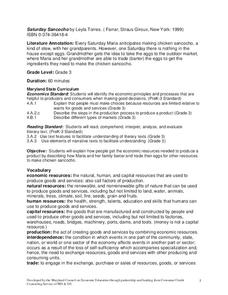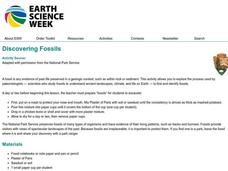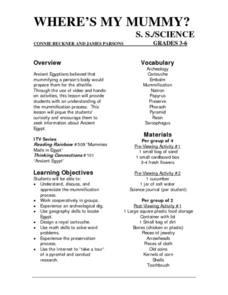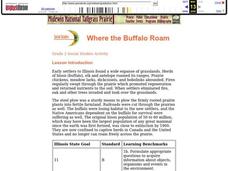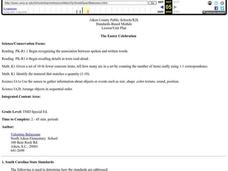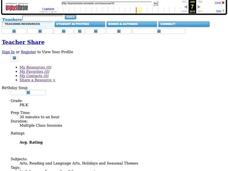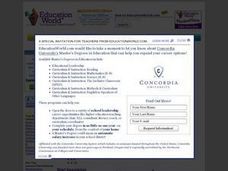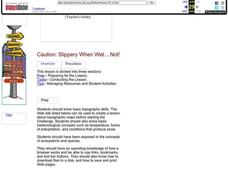Curated OER
Saturday Sancocho
Second graders identify the economic principles and processes that are helpful to producers and consumers when making good decisions. Students will read, comprehend, interpret, analyze, and evaluate literary text as well as explain how...
ProCon
Vegetarianism
What do Mike Tyson, Ellen DeGeneres, and Paul McCartney have in common? They're all famous vegetarians. Using the resource, scholars learn about the pros and cons of eating a vegetarian diet. They read a fascinating history of...
Curated OER
Harvesting Hope: The Story of Cesar Chavez
Students identify productive resources that are important to migrant workers. In this lesson on resources, students give examples of natural resources, human resources and capital resources that apply to migrant workers. This lesson has...
Curated OER
Evaluating Information Resources
Students identify at least five aspects to be examined in determining the validity of information presented on a website. They classify websites into highly trustable, trustable or questionable information sources. In addition, they...
Curated OER
Discovering Fossils
Students explore fossils. For this fossils geology lesson, students use tools to reveal embedded "fossils" (made with plaster of Paris by the teacher-instructions included), then describe and illustrate their findings.
Curated OER
Agriculture: Oklahoma's Legacy
Sixth graders explore agriculture as it relates to crops over the course of a series of historical events. They read and create a timeline of the 50-year increments that depict important cause and effect events. Students then use...
Curated OER
Forest Habitat Fragmentation
Seventh graders discuss the loss of animal habitats and the importance of refuge areas for them. They collect small pictures of animals found in their state and glue them to an outline of their state according to their range. Finally,...
Curated OER
Chinese History and Culture Quiz 1
In this Chinese history worksheet, learners answer 10 multiple choice and short answer questions based on their knowledge of Chinese history and culture.
Curated OER
Where's My Mummy: Preservation Techniques
To observe preservation techniques firsthand, learners dry a flower in sand and compare cucumber slices soaked in salt water for a week with slices left out to dry in the open air. Video resources (not attached) include one about mummies...
Curated OER
Where the Buffalo Roam
Second graders explore what life in the Chicago area was like hundreds of years ago. They discuss how settlers impacted the environment, and why there are no longer herds of buffalo in the Chicago area today. They read an article and...
Curated OER
Class Soup
Youngsters identify the ingredients in a can of vegetable soup and record a recipe for the soup. They volunteer to bring in soup ingredients, graph the quantities of each vegetable in the soup, and make the soup with help from parents....
Curated OER
The Easter Celebration
Young scholars read a short story about Easter. They recognize and point to pictures of the key words (egg, chicken, rabbit, basket, flower). They make an Easter basket and count how many chickens can fit inside. They also practice...
Curated OER
Spread of Disease
Seventh graders discover facts about the human body. In this diseases lesson plan, 7th graders understand different kinds of diseases, how disease spreads, how diseases have changed and preventative medicines. Students debate...
Curated OER
What is the Evidence for Evolution?
Students identify one object that would tell the story of their lives. In groups, they determine what can and cannot be told from objects left behind. After watching a video, they compare and contrast chicken bones to human bones. To...
Curated OER
A Meat By Any Other Name. . .
Students, using a New York Times article as a springboard, discuss how food reflects different aspects of a culture and reasons why cultural differences in food are seen as bizarre or, oftentimes, cruel by members of other societies.
Curated OER
Unearthing the Past
Students analyze artifacts from an early society to determine information relating to daily life in that society. They consider which artifacts from our society would be most valuable to future archeologists.
Curated OER
Birthday Soup
Students recognize their birthday and how it is written. In this lesson, students read a poem about birthdays. Students create a soup bowl that has their birthday month, day and year in it.
Vermilionville
Mardi Gras Elementary
You don't have to visit Vermilionville to experience the Cajun traditions of Mardi Gras. After examining pictures and hearing stories about these colorful traditions, learners create their own Courir de Mardi Gras masks.
Curated OER
Make A Mummy: The Science of Mummification
Students research the history of mummification. They work together to create an apple mummy. They write a paragraph about what they gathered while doing the experiment.
Curated OER
Written Clues About the Past
Third graders investigate written clues from the past. In this clues from the past lessons, 3rd graders read and entry called, "Rick's Backyard Site." They complete the associated resource sheets. They read about a second site and use a...
Curated OER
Caution: Slippery When Wet....Not!
Young scholars and manipulate data from Internet sites to design a downhill ski course that meets the International Federation of Skiing's requirements for a safe and fair competition.
Curated OER
Agriculture: Oklahoma's Legacy
Students continue exploring the history of Oklahoma Agriculture in this lesson. They trace several historical migrations to the state of Oklahoma. They simulate the customs and conditions of a chosen migration. Vocabulary and resource...
Curated OER
Shopping: In a Cafe
Students explore English by participating in a role-playing activity. In this food ordering lesson, students utilize new vocabulary terms to conduct short dialogues with fictitious servers in a Cafe role-play activity. Students analyze...
